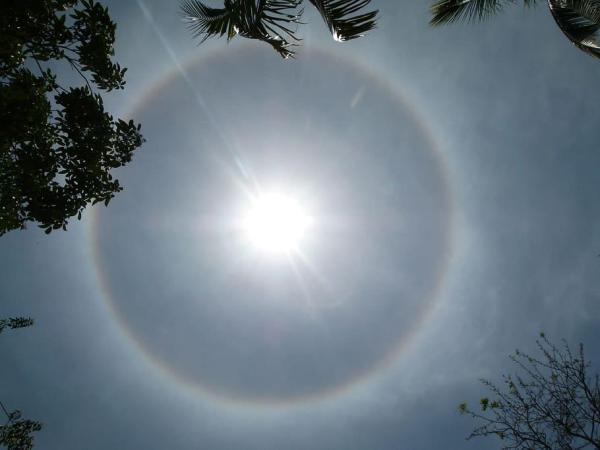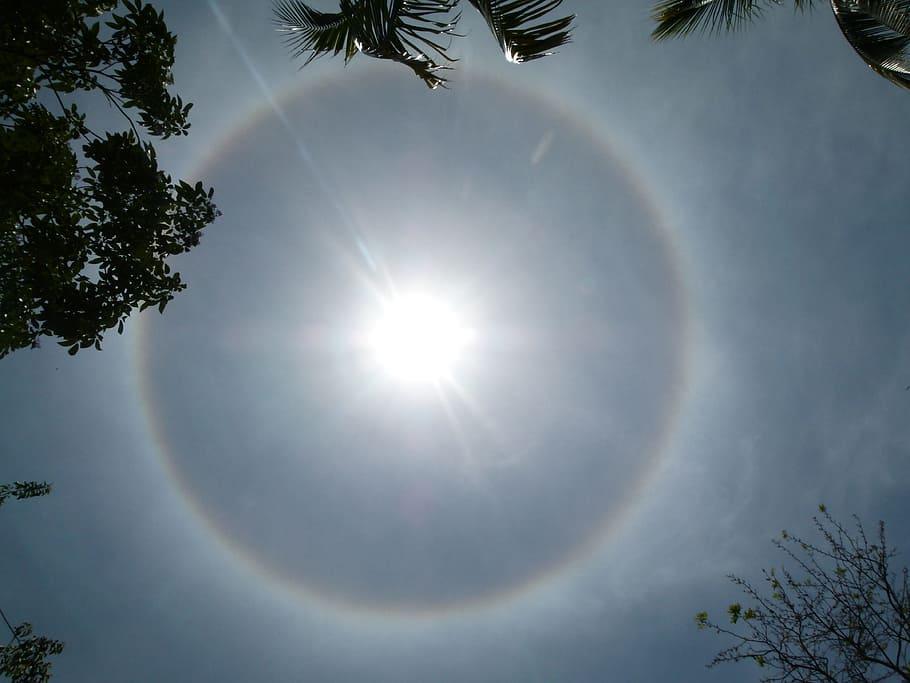What Are Sun Halos? - Definition and Causes


The sky is an ever-changing canvas, and at times it can surprise us with breathtaking displays of light and color. One of these phenomena is the solar halo, also known as the sun halo. A solar halo appears as a luminous ring, circle, or arc around the sun, often displaying a range of colors. But what causes this stunning spectacle to occur, and why is it so rare?
In the following article from thedailyECO, we will explore the science behind solar halos, the atmospheric conditions that give rise to them, and how they differ from other optical phenomena.
What is a solar or sun halo?
A solar halo, also known as a 22-degree halo or a sun halo, is an atmospheric phenomenon that occurs when the Sun shines through ice crystals in the atmosphere.
Ice crystals that produce halos are usually found in cirrus or cirrostratus clouds located in the upper troposphere, which is around 5-10 km (3.1-6.2 mi) high. However, in colder temperatures, they can also be present closer to the ground, known as diamond dust.
The ring of light is often white, but it can also have colors, including red, orange, yellow, and blue. The colors are caused by the refraction and dispersion of light as it passes through the ice crystals. The halo is often visible when the Sun is low on the horizon, and it can be seen from anywhere on Earth. Halos come in various forms, from rings and arcs with colors to spots and other shapes visible in the sky.
They are a beautiful sight to see and can be captured in photographs, but they are also a sign of atmospheric conditions that can lead to weather changes, such as rain or snow. However, it is important to exercise caution when photographing solar halos, as pointing a camera directly at the unfiltered sun can cause damage. It is also crucial to avoid looking directly at the sun, even during periods when it is less bright due to cloud cover or fog.
You might be interested in this other article, where we explain what celestial bodies are.

What causes sun halos?
As mentioned before, a solar or sun halo is produced when sunlight passes through ice crystals in the atmosphere. Let us take a closer look at the specific conditions for a solar halo to occur:
- High-altitude clouds, particularly cirrostratus and cirrostratus nebulosus, form in the upper troposphere (5–13 kilometers high). These clouds consist of tiny ice crystals suspended in the atmosphere.
- Sunlight passes through the ice crystals and is refracted, or bent, as it enters the crystal.
- The refraction causes the light to separate into its spectral colors (red, orange, yellow, green, blue, indigo, and violet).
- The separated colors exit the crystal at different angles, creating a circular rainbow-like effect around the sun. If the ice crystals reflect sunlight instead of refracting it, the halo appears white.
- Depending on the orientation and density of the ice crystals in the cloud, the halo may appear with varying degrees of intensity and shape, ranging from circular rings to arcs and spots in the sky.
- The most common ice crystals that produce solar halos are hexagonal, which results in a circular ring shape with a diameter of 22 degrees around the Sun.
Does a sun halo predict rain?
The belief that a solar halo predicts rain has been around for a long time and is based on some truth. When a solar halo appears, it is often a sign that there is high-altitude moisture in the atmosphere, which can be a precursor to a storm or rain.
Cirrostratus clouds, which are responsible for solar halos, are often precursors to warm fronts, which bring rain. As the warm front approaches, the temperature, and humidity increase, causing the cirrostratus clouds to form and a solar halo to appear. However, it is important to note that not all solar halos are followed by rain. Sometimes, the moisture in the atmosphere does not result in a storm, or the storm may move in a different direction.
In some cases, solar halos are also often associated with snowfall because they are formed by the refraction of light through ice crystals suspended in the atmosphere. Additionally, when snow is falling, it can create a similar optical effect called a "snowbow" or "fogbow", which is essentially a rainbow that is formed by the refraction of light through snowflakes or water droplets in fog.

What is the difference between a sun halo and a rainbow?
While both solar halos and rainbows are atmospheric optical phenomena, they are fundamentally different in their underlying mechanisms, appearance, and location in the sky.
Rainbows are formed when sunlight is refracted, reflected, and dispersed through water droplets in the air, typically after a rain shower or when there are water droplets in the atmosphere. The water droplets act as tiny prisms, breaking down the white light into its component colors, which we see as a colorful semicircular arc. Rainbows appear on the opposite side of the sky from the sun, and their colors range from red on the outer edge to violet on the inner edge.
In contrast, solar halos are formed by the refraction of sunlight through ice crystals in the atmosphere, typically in cirrus or cirrostratus clouds. The ice crystals act like tiny prisms, refracting the sunlight and breaking it down into its component colors, just like in a rainbow. However, the circular or ring-shaped band of colors around the sun is much wider than a rainbow, and the colors typically go from red on the inside to blue or violet on the outside.
Another key difference between solar halos and rainbows is their location in the sky. Rainbows are typically seen on the opposite side of the sky from the sun, while solar halos are seen around the sun itself.
You might be interested in this other article, where we explain why the sun is yellow.
If you want to read similar articles to What Are Sun Halos? - Definition and Causes, we recommend you visit our Facts about nature category.







